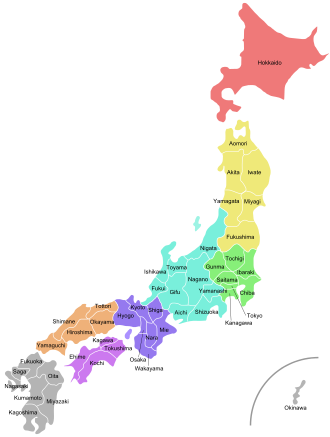
Back Prefekture van Japan Afrikaans محافظات اليابان Arabic জাপানৰ প্ৰশাসনিক অঞ্চল Assamese Prefeutures de Xapón AST Préféktur Jepang BAN Prefektuan vo Japan BAR Japuonėjės prefektūras BAT-SMG Прэфектуры Японіі Byelorussian Префектура (Япония) Bulgarian Prefektur Japang BJN
| Prefecture 都道府県 Todōfuken | |
|---|---|
 | |
| Category | First level administrative division of a unitary state |
| Location | Japan |
| Number | 47 Prefectures |
| Populations | 605,000 (Tottori) – 14,135,000 (Tōkyō) |
| Areas | 1,861.7 km2 (718.8 sq mi) (Kagawa) – 83,453.6 km2 (32,221.6 sq mi) (Hokkaido) |
| Government |
|
| Subdivisions |
|
Japan is divided into 47 prefectures (都道府県, todōfuken, [todoːɸɯ̥ꜜkeɴ] ⓘ), which rank immediately below the national government and form the country's first level of jurisdiction and administrative division. They include 43 prefectures proper (県, ken), two urban prefectures (府, fu: Osaka and Kyoto), one regional prefecture (道, dō: Hokkaidō) and one metropolis (都, to: Tokyo). In 1868, the Meiji Fuhanken sanchisei administration created the first prefectures (urban fu and rural ken) to replace the urban and rural administrators (bugyō, daikan, etc.) in the parts of the country previously controlled directly by the shogunate and a few territories of rebels/shogunate loyalists who had not submitted to the new government such as Aizu/Wakamatsu. In 1871, all remaining feudal domains (han) were also transformed into prefectures, so that prefectures subdivided the whole country. In several waves of territorial consolidation, today's 47 prefectures were formed by the turn of the century. In many instances, these are contiguous with the ancient ritsuryō provinces of Japan.[1]
Each prefecture's chief executive is a directly elected governor (知事, chiji). Ordinances and budgets are enacted by a unicameral assembly (議会, gikai) whose members are elected for four-year terms.
Under a set of 1888–1890 laws on local government[2] until the 1920s, each prefecture (then only 3 -fu and 42 -ken; Hokkaidō and Okinawa-ken were subject to different laws until the 20th century) was subdivided into cities (市, shi) and districts (郡, gun) and each district into towns (町, chō/machi) and villages (村, son/mura). Hokkaidō has 14 subprefectures that act as General Subprefectural Bureaus (総合振興局, sōgō-shinkō-kyoku, "Comprehensive Promotion Bureau") and Subprefectural Bureaus (振興局, shinkō-kyoku, "Promotion Bureau") of the prefecture. Some other prefectures also have branch offices that carry out prefectural administrative functions outside the capital. Tokyo, the capital of Japan, is a merged city-prefecture; a metropolis, it has features of both cities and prefectures.
Each prefecture has its own mon for identification, the equivalent of a coat of arms in the West.
- ^ Nussbaum, Louis-Frédéric, 2002: "Provinces and prefectures" in Japan encyclopedia, p. 780.
- ^ prefectural code (府県制, fukensei), district code (郡制, gunsei), city code (市制, shisei), town and village code (町村制, chōsonsei)